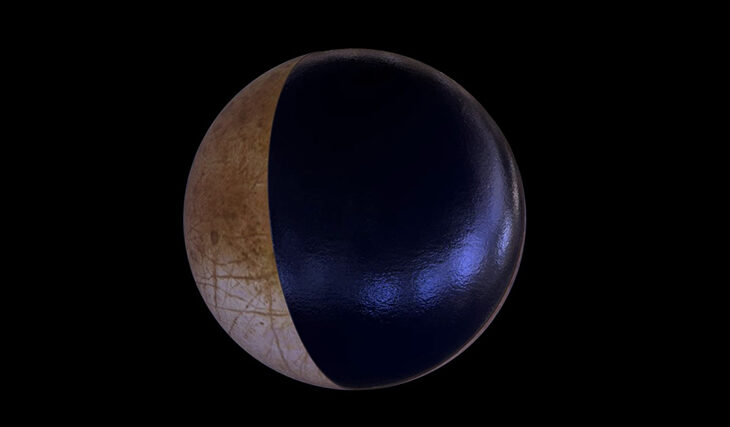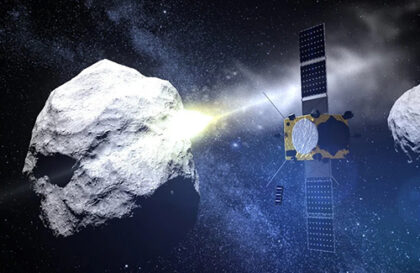Europa
Four decades ago, the Voyager spacecraft took the first detailed image of Europa, one of Jupiter’s many moons. Europa stood out with its icy surface, dotted with brown cracks reminiscent of the venous network on the eyeball. Subsequent space missions to the outer solar system collected more data about Europa, turning it into a critical site for NASA and ESA research in the search for life.
Europa is one of Jupiter’s many moons. Credit: NASA/Jet Propulsion Laboratory for NASA’s Science Mission Directorate.
NASA’s Galileo mission, orbiting around Jupiter, studied the planet’s magnetic field near Europa. Research between 1995 and 2003 indicated the presence of a conducting fluid, possibly a salty ocean, beneath Europa’s ice sheet, influencing the magnetic field. After analyzing data in 2018, scientists found signs of potential plumes of water.
In 2013, scientists said they used NASA’s Hubble Space Telescope to detect the elements hydrogen (H) and oxygen (O), which make up water (H2O), in Europa’s atmosphere in its plumes. Later, other researchers used Hubble to obtain additional evidence of possible eruptions from these plumes. They recorded finger-like projections becoming visible against Jupiter’s background as the moon passed before the planet.
Detecting water vapor on other planets is challenging due to spacecraft limitations and the influence of Earth’s atmosphere on data from ground-based telescopes. Scientists used sophisticated mathematical and computer modeling to minimize distortion from Earth’s atmosphere and distinguish its water from water in Europa’s atmosphere.
The Keck Observatory used a spectrograph that analyzes the chemical composition of planetary atmospheres by measuring the infrared light emitted or absorbed by water molecules when exposed to solar radiation.
Scientists had evidence of critical ingredients for life, including liquid water beneath Europa’s icy surface and possible water geysers erupting into the atmosphere. Still, there was no direct evidence of water in these plumes.
However, discovering water vapor in Europa’s atmosphere has strengthened confidence in a vast liquid ocean beneath the surface, perhaps more significant than Earth’s. The discovery also points to dynamic conditions in the ocean, where water is periodically released to the surface and into the atmosphere.
There are other explanations for the origin of water plumes on Europa. One theory suggests that water and steam arise from surface meltwater reservoirs beneath the lunar surface. There is also speculation that Jupiter’s intense radiation may release water particles from Europa’s ice cover. However, recent studies do not support this mechanism as the primary source of the detected water.
Eventually, we must get closer to Europe to see what is happening.
Enceladus
Saturn’s moon, Enceladus, sends out regular plumes of water vapor — as seen here as imaged by the Cassini spacecraft — known to contain complex organic molecules. Credit: NASA/JPL-CALTECH.
Why are there no parallel large missions planned for Enceladus? After all, the plumes (or geysers) coming from the Moon are known to be persistent and significant here.
One space mission was proposed for NASA’s New Frontiers competition last year but was not selected, although it received positive reviews. The German space agency has been studying a mission to Enceladus since 2012.
Meanwhile, Yuri Milner, a Russian billionaire living in the United States, is working with a NASA team to develop a relatively inexpensive spacecraft to fly through the plumes of Enceladus and study for organic compounds and possible traces of life. Milner and his colleagues are convinced of the need to explore Enceladus for life without waiting for larger NASA missions such as the expensive Europa Clipper mission.
In general terms, the geysers on Enceladus, which sometimes create vapor clouds, originate in the moon’s south polar region. They were initially thought to result from tidal processes and heat from the subsurface ocean, with ice cracks allowing water and steam to escape. However, a new hypothesis has recently been put forward about this heat’s more complex origin.
Measurements by the Cassini mission in 2017 showed the presence of molecular hydrogen in the plumes of Enceladus. This indicates that water on Enceladus is formed from the interaction of water with heated minerals on the moon’s ocean floor, likely including hydrothermal vents similar to Earth’s hydrothermal chimneys. These conditions, known on Earth as breeding grounds for life, create hydrogen and hydrogen compounds that provide energy for microbes.
Thus, although it cannot be quantified, the likelihood of simple life on Enceladus increased after this discovery.
Missions to the satellites could also find a life-promoting chemical soup and similar signs of deep interactions between the salty ocean and rock minerals heated hydrothermally, radiation, tidal pressure, or perhaps all of the above.
Banner image: Credit: NASA/Jet Propulsion Laboratory for NASA’s Science Mission Directorate.
Image credit:
https://europa.nasa.gov/
https://astrobiology.nasa.gov



